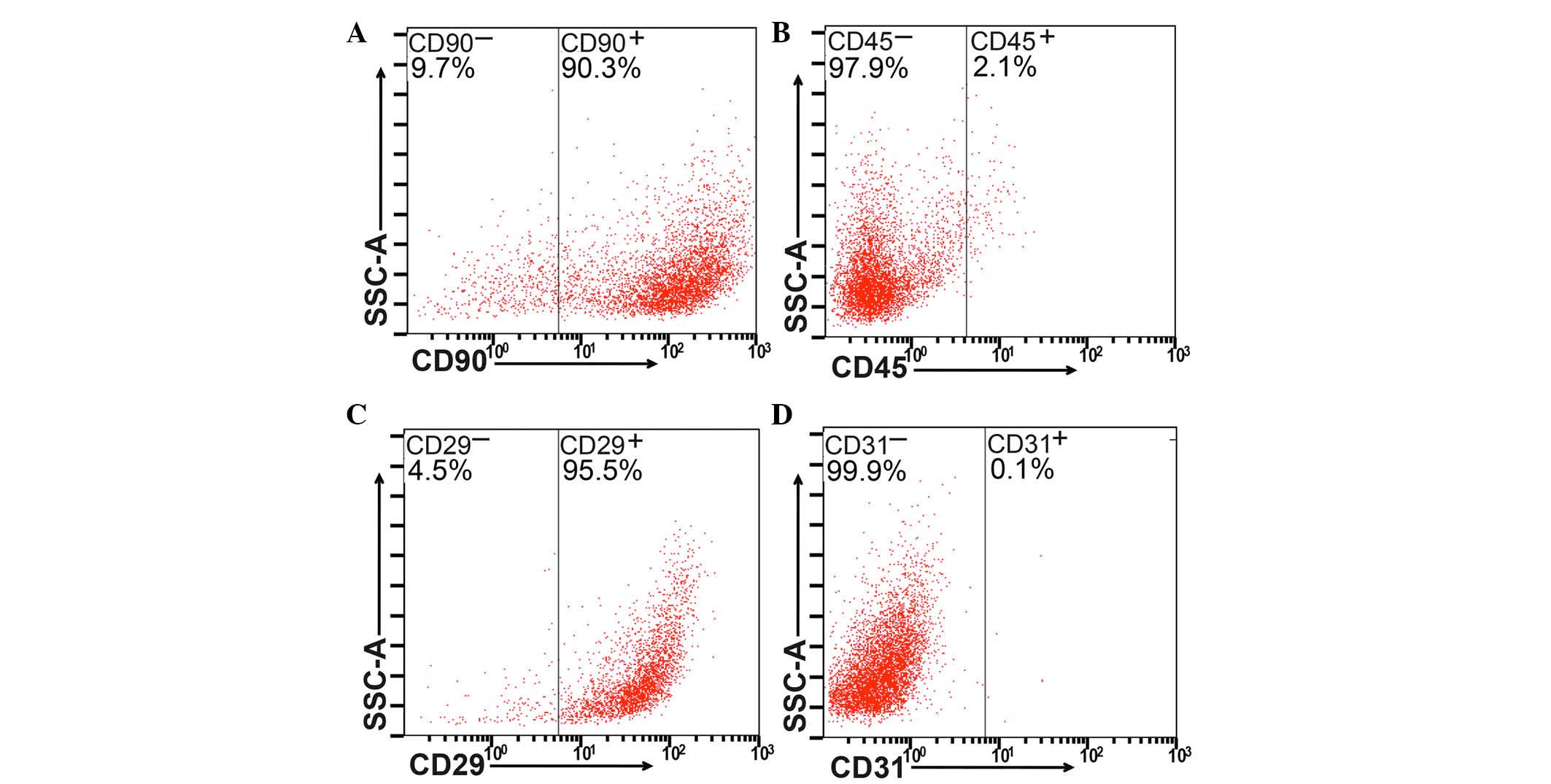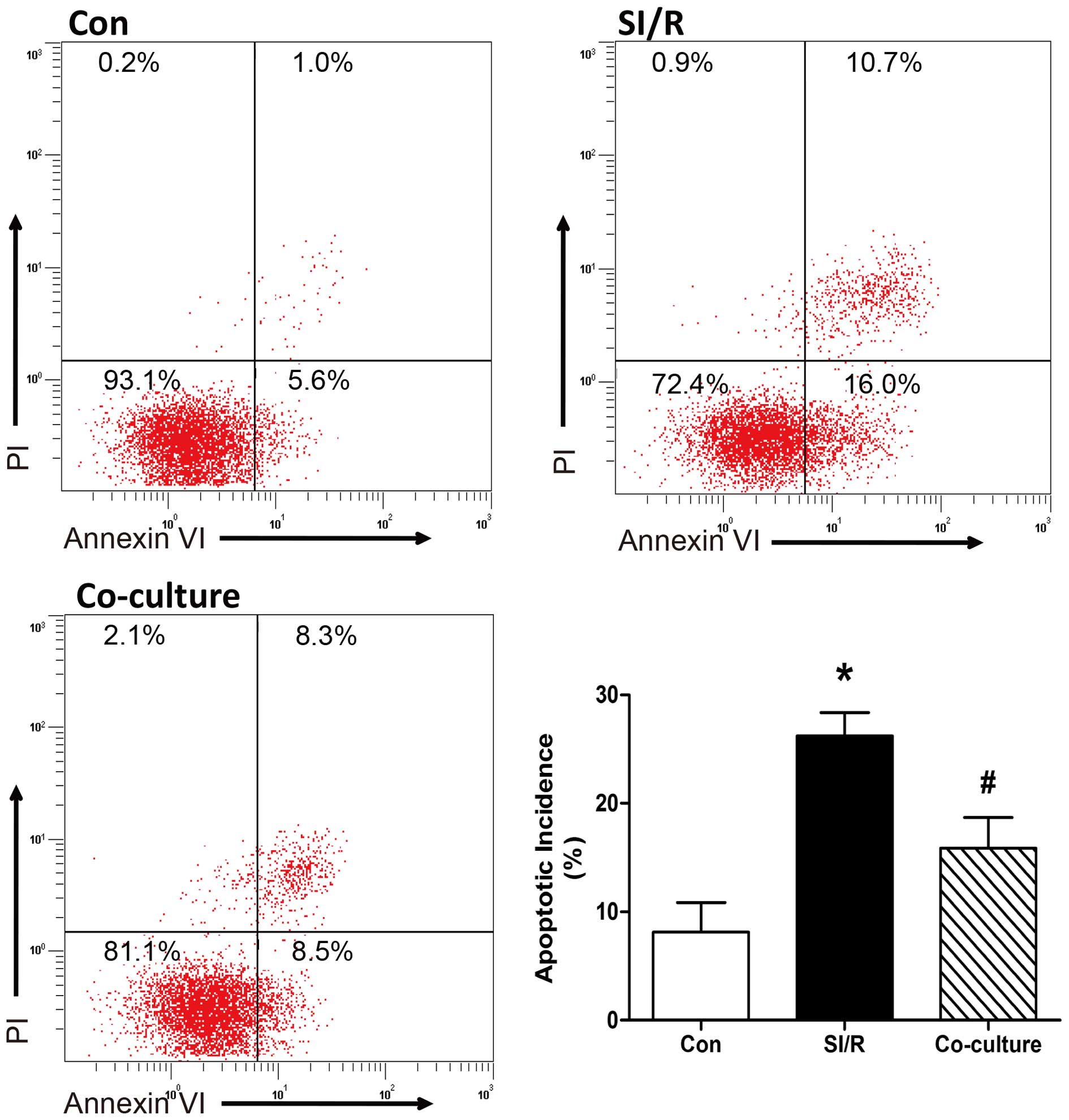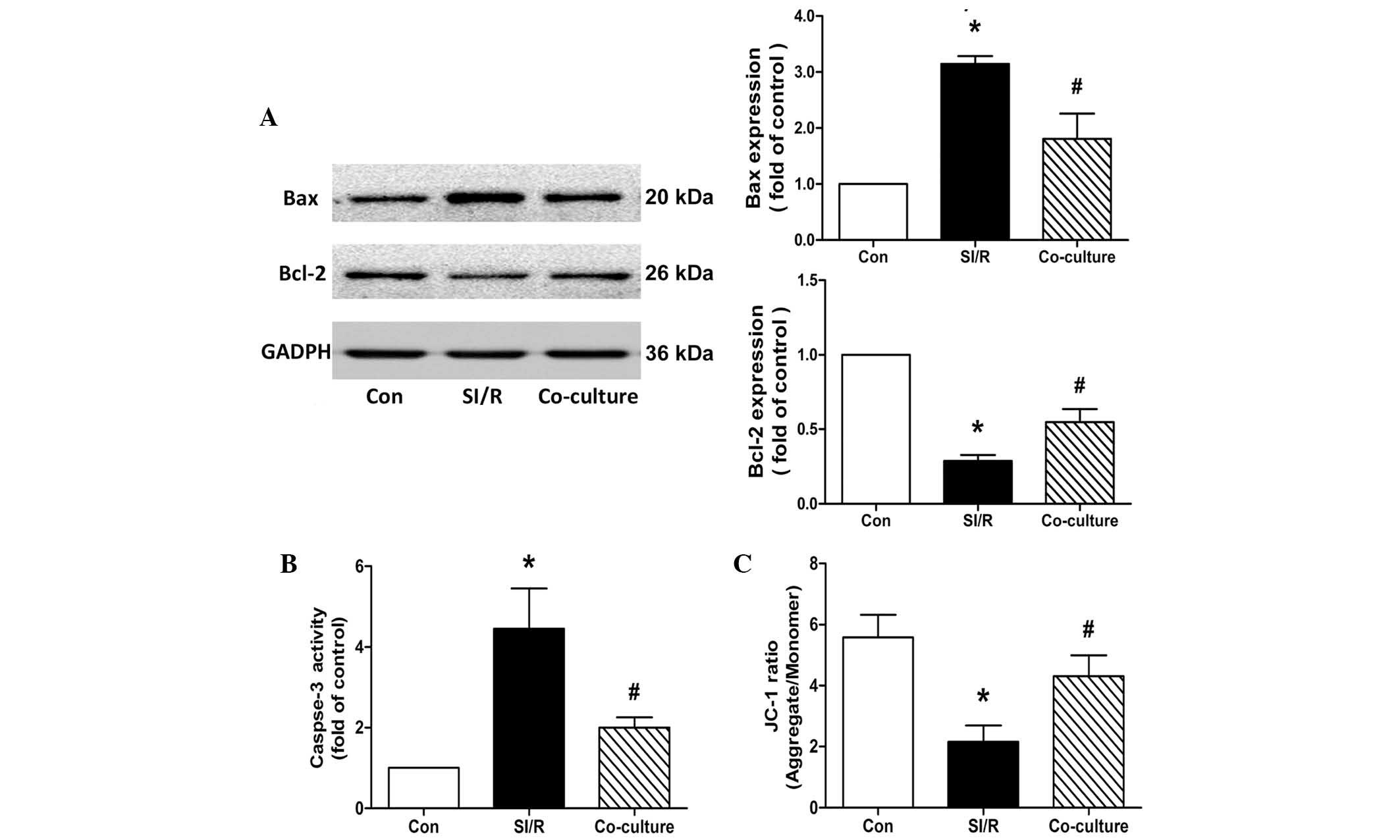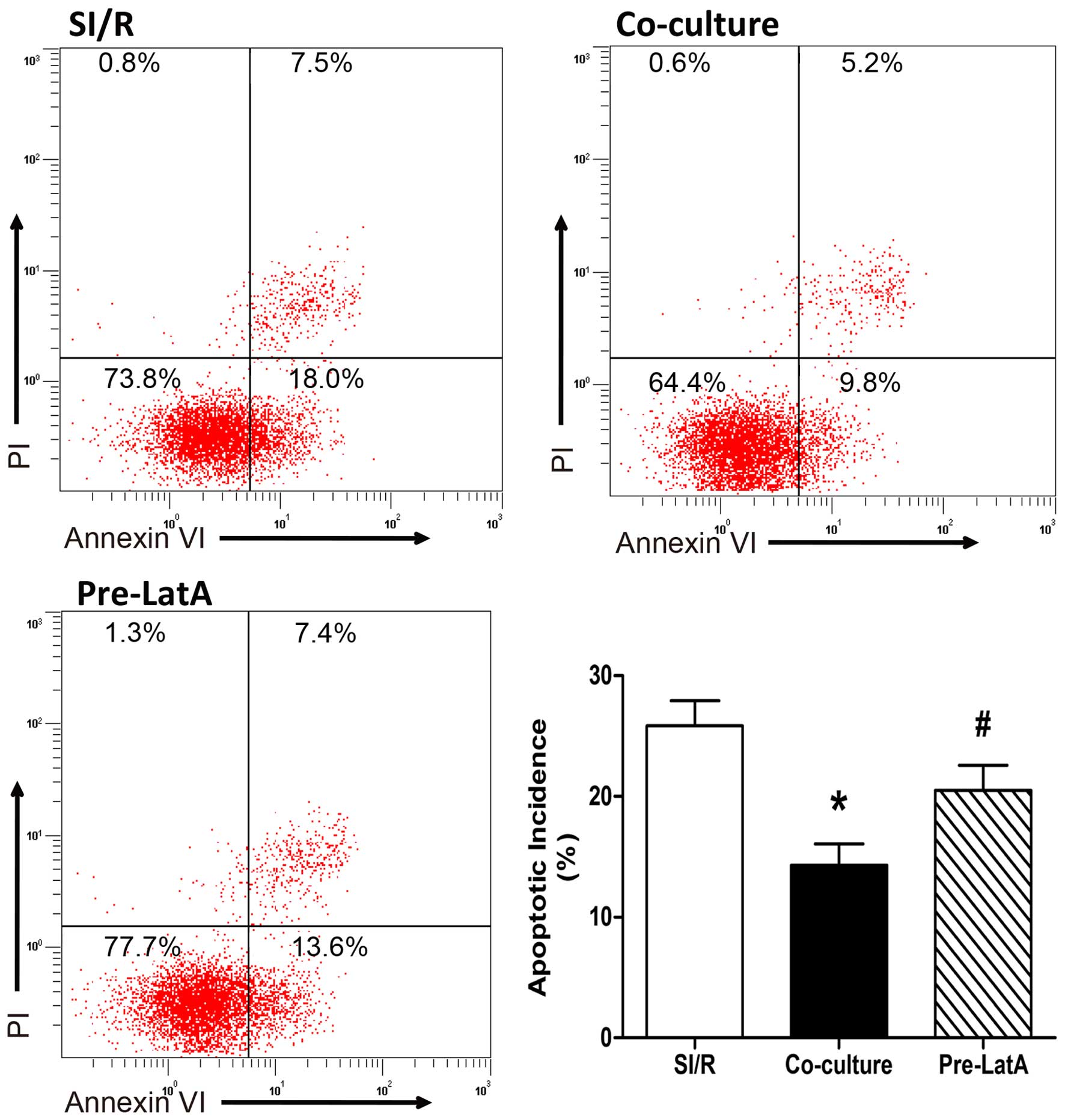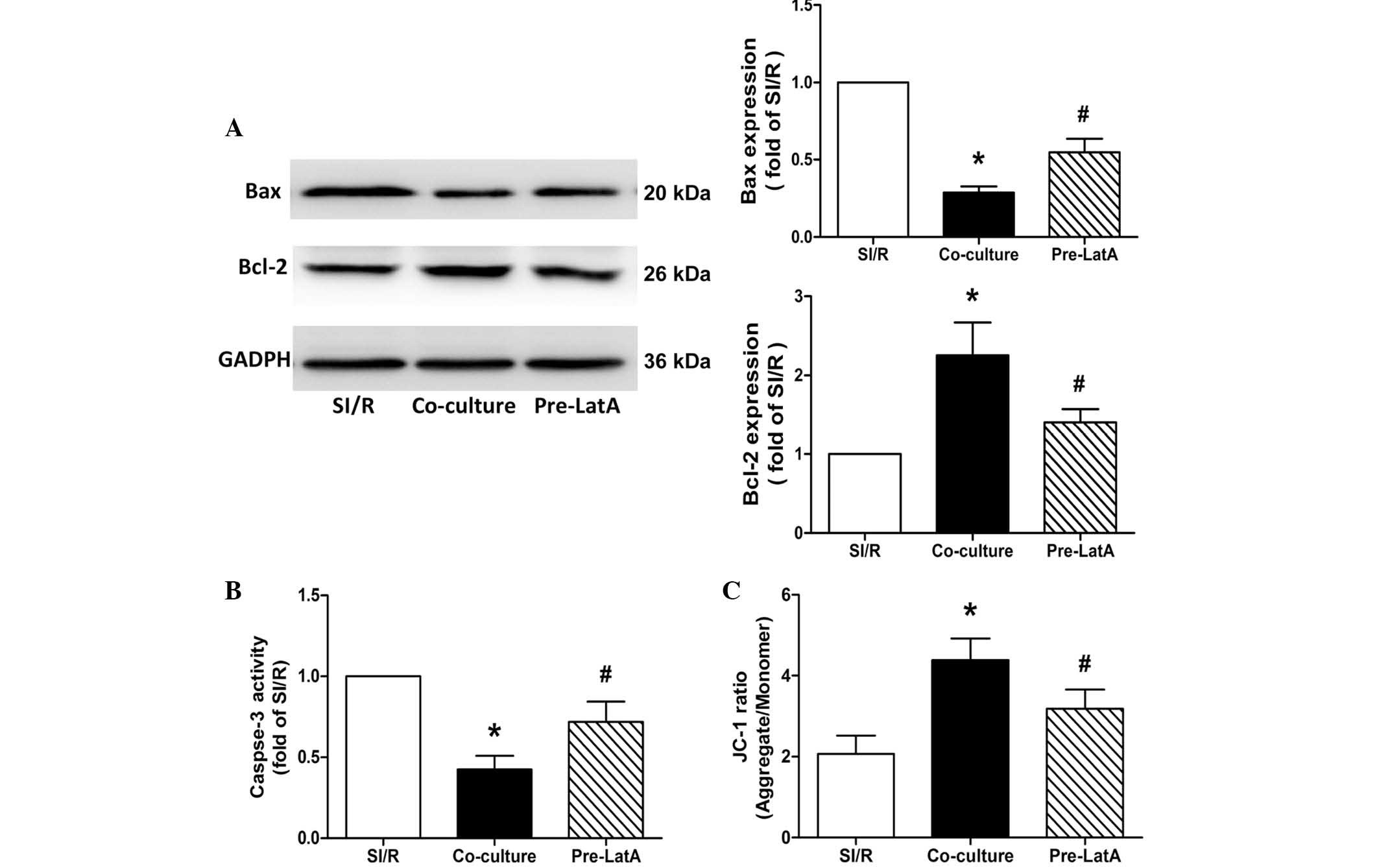Bone marrow‑derived mesenchymal stem cells rescue injured H9c2 cells via transferring intact mitochondria through tunneling nanotubes in an in vitro simulated ischemia/reperfusion model
- Authors:
- Published online on: December 28, 2015 https://doi.org/10.3892/mmr.2015.4726
- Pages: 1517-1524
-
Copyright: © Han et al. This is an open access article distributed under the terms of Creative Commons Attribution License.
Abstract
Introduction
Ischemic heart disease (IHD) has gradually become one of the major threats to quality of life (1). As a leading contributor to mortality rates in cardiovascular disease (CVD), IHD accounts for 42% of the mortality rates in patients with CVD (2,3). Although the use of timely and appropriate reperfusion strategies, including thrombolytic therapy, percutaneous coronary intervention and coronary artery bypass grafting, have proved efficient and beneficial, reperfusion itself causes further injury to the ischemic cardiomyocytes, resulting in the induction of apoptosis or even necrosis (4). Mitochondrial dysfunction has been found to be critical, in that ischemia-mediated damage to the mitochondrial electron transport chain persists during reperfusion (5). This mitochondrial dysfunction not only decreases energy production, but also increases the generation of intracellular reactive oxygen species and activates the executioner caspase cleavage pathway to trigger cell death during reperfusion (6). The injured myocardium undergoes an orchestrated remolding process, which is associated with adverse clinical outcomes (7). Reducing the deleterious impact of ischemia/reperfusion (I/R) injury is, therefore, important in the treatment of IHD.
Mesenchymal stem cells (MSCs) expressing cluster of differentiation (CD)105, CD73 and CD90, and rarely CD45, CD34 and human leukocyte antigen-DR, can be isolated from bone marrow, adipose tissue and the umbilical cord blood (8,9). Due to their numerous advantages, including abundant sources, high levels of activity, immune privilege, high proliferation and differentiation potential and nutrient secretion, the use of MSCs in cell therapies are considered among the most promising approaches to repair damaged cardiac tissue in IHD, including myocardial infarction and heart failure (10–12). MSCs, as multipotent non-hematopoietic stem cells, typically originating from the bone marrow, have been widely used in general transplantation investigations. However, the overall effect of regenerative stem cell therapy in the improvement of human heart function is not considerable (13,14). A number of animal studies have produced results demonstrating significant cardioprotective effects. However, following prudent review, the precise effects that MSCs have on myocardiocytes, and the underlying mechanism remain controversial. Several studies indicated that MSCs delivered to the heart successfully differentiated into cardiomyocytes (15) and fibroblasts (16), which are the predominant cellular constituents of the heart, whereas others demonstrated that they did not (16) and suggested that their therapeutic effects were paracrine in nature (17). Spees et al reported that mitochondria can be actively transferred from stem cells to recipient cells with nonfunctional mitochondria, resulting in a significant amelioration of aerobic respiration (18). In vivo animal investigations are inherently limited, due to the complication of whether the observed therapeutic effect results from in situ cells being 'nourishedʼ by MSCs, or whether it is an artifact of MSCs, which exhibit high activity and differentiation potential.
In the present study, the role of bone marrow-derived MSCs (BM-MSCs) in the survival of H9c2 cardiomyocytes in a simulated I/R (SI/R) model was investigated. A co-culture system was established to simulate the direct cell-to-cell interactions. Consistently, the anti-apoptotic effects and mitochondrial transfer by transient tunneling nanotube (TNT)-like connections between cells were directly investigated in vitro, through which the exact changes induced by BM-MSCs in the H9c2 cells, and the possible mechanisms of direct intercellular communication, were measured.
Materials and methods
Cell isolation and culture
MSCs were isolated from green fluorescent protein (GFP)-expressing Sprague-Dawley rats (age, 3 months; weight, 250–300 g), which were obtained from the Second Military Medical University Laboratory Animal Center (Shanghai, China). The rats were housed in a specific pathogen-free facility (21±2°C and 50±15% humidity) under a 12 h light/dark cycle with free access to food and water. The present study was approved by the Ethics Committee of the Second Military Medical University, Shanghai, China (no. 13071002114). Primary BM-MSCs were isolated and cultured, as described previously (19), at 37°C with 5% CO2. Cells were harvested when they reached 80–90% confluence. The harvested cells were centrifuged at 500 × g for 15 min at 4°C and were subsequently resuspended in Dulbecco's modified Eagle's medium (DMEM)/F-12 culture medium containing 10% fetal bovine serum (FBS), 100 µg/ml streptomycin and 100 U/ml penicillin (Gibco; Thermo Fisher Scientific, Inc., Waltham, MA, USA). Cells at the third passage were subjected to flow cytometric analysis to examine the expression levels of the CD29, CD90, CD31 and CD45 surface markers (Fig. 1A–D).
Cells of the H9c2 rat ventricular cell line were obtained from the American Type Culture Collection (Manassas, VA, USA). The cells were maintained in DMEM/F-12 culture medium containing 10% FBS, 100 µg/ml streptomycin and 100 U/ml penicillin (Gibco; Thermo Fisher Scientific, Inc.) in a water-saturated atmosphere of 5% CO2 and 95% air at 37°C.
Establishment of a co-culture system and cell treatment
To construct the co-culture system, the appropriate density of H9c2 cells were plated into 6-well culture plates at a density of 1×106 cells/well, and then divided into different groups based on the specific treatments performed. An in vitro model of simulated ischemia/reperfusion (SI/R) was used, as previously described, with several modifications (20). Briefly, the medium was replaced by serum- and glucose-deficient DMEM (21), and the cells were placed into a hypoxic chamber (95% N2; 5% CO2) at 37°C for 12 h. The cell were then reoxygenated at 37°C for 6 h with DMEM containing 10% FBS. The cells control group were treated with complete medium throughout the experiment. The cells in the SI/R group were subjected to SI/R, as described above. In the co-culture group, BM-MSCs (1:1) were directly seeded into the co-culture system during reoxygenation. In the remaining group, the co-cultured BM-MSCs were pretreated with latrunculin-A (LatA; 10 nM; Sigma-Aldrich, St. Louis, MO, USA) at 37°C for 4 h (pre-LatA group).
Detection of apoptotic rates using flow cytometry
The H9c2 cells were isolated from the co-cultures using a MoFlo XDP high-speed flow cytometry sorter (Beckman Coulter Brea, CA, USA). Cell apoptosis was measured using Annexin V-fluorescein isothiocyanate (FITC) and propidium iodide (PI) with an apoptosis detection kit (BD Pharmingen, San Diego, CA, USA), according to the manufacturer's protocol. The samples were analyzed on a fluorescence activated cell sorter (Cytomic FC500; Beckman Coulter) within 1 h. The numbers of apoptotic cells, including Annexin V-positive/PI-negative and double-positive cells, were counted and expressed as a percentage of the total cell count.
Western blot analysis
H9c2 cells were washed twice with PBS, and lysed using ProteoJET Mammalian Cell Lysis Reagent (Thermo Fisher Scientific, Inc.) to extract cytoplasmic proteins. Protein concentrations were determined using the bicinchoninic acid (Beyotime Institute of Biotechnology, Haimen, China). Following denaturation with loading buffer, 60 µg protein extracts were subjected to 8% SDS-PAGE and were electrophoretically blotted onto nitrocellulose membranes (Novex, San Diego, CA, USA). The membranes were blocked with 5% non-fat milk in Tris-buffered saline with Tween-20 (Bio-Rad Laboratories, Inc., Hercules, CA, USA), and were subsequently probed overnight at 4°C with rabbit polyclonal anti-rat antibodies against B cell lymphoma-2 (Bcl-2; 1:1,000; polyclonal; cat. no. 2876), Bcl-2-associated X protein (Bax; 1:1,000; polyclonal; cat. no. 2772) and GADPH (1:5,000; monoclonal; cat. no. 5174). The membranes were then incubated with the respective horseradish peroxidase-conjugated goat anti-rabbit IgG secondary antibodies (1:5,000; cat. no. 7074) at room temperature for 1 h. Immunoreactive bands were detected using an enhanced chemiluminescence system (EMD Millipore, Billerica, MA, USA) and quantified using Image-Pro Plus 6.0 software(Media Cybernetics, Inc., Rockville, MD, USA). All antibodies for western blotting were purchased from Cell Signaling Technology, Inc. (Danvers, MA, USA).
Caspase-3 activity assay
Caspase-3 activity was determined using a Caspase-3 Activity kit (Beyotime Institute of Biotechnology), which is based on the caspase-3-mediated conversion of acetyl-Asp-Glu-Val-Asp p-nitroanilide into the yellow formazan product, p-nitroaniline. The assay was performed according to the manufacturer's protocol. Caspase-3 activity was quantified on a microplate spectrophotometer (PowerWave HT Microplate spectrophotometer; Biotek Instruments, Inc., Winooski, VT, USA) at 405 nm. Caspase-3 activity was expressed as the fold-change in enzyme activity, compared with synchronized cells.
Measurement of mitochondrial membrane potential (Δψm)
Following the specific treatments, the Δψm of the H9c2 cells was assessed using a lipophilic cationic probe, 5,5′,6,6′-tetra-chloro-1,1′,3,3′-tetraethylbenzimidazole-carbocyanide iodine (JC-1; 5 µmol/l; Invitrogen; Thermo Fisher Scientific, Inc.), which exhibits potential-dependent accumulation in mitochondria. Briefly, the H9c2 cells (1×106 cells/ml) were incubated with JC-1 for 30 min at 37°C. The fluorescence was detected using a microplate reader (Tecan Infinite 200; Tecan, Männedorf, Switzerland). The wavelengths of excitation and emission were 514 and 529 nm to detect the monomeric form of JC-1, and 585 and 590 nm to detect the aggregation of JC-1. The ratio of mitochondrial JC-1 aggregates and monomers was considered representative of the Δψm of H9c2 cells.
Staining of cells and confocal microscopy
To trace the intercellular exchange of mitochondria, GFP BM-MSCs were labeled with MitoTracker Deep Red (Invitrogen; Thermo Fisher Scientific, Inc.), according to the manufacturer's protocol. Briefly, the cells (1×106 cells/ml) were resuspended in pre-warmed (37°C) staining solution containing the MitoTracker® probe (50 nM) for 30 min. Following staining, the cells were washed three times in PBS, and resuspended in fresh pre-warmed medium.
In the group of H9c2 cells subjected to 12 h ischemia, labeled GFP BM-MSCs were directly seeded into the culture system on glass slides. Following 6 h of mixture under conditions of reoxygenation, the glass slides containing the two types of cell were labeled with DAPI (10 µg/m; Beyotime Institute of Biotechnology) for 5 min. Images were captured by confocal microscopy (Leica Microsystems GmbH, Wetzlar, German) within 1 h, and analyzed using Leica LAS AF Lite software (Leica Microsystems GmbH).
Statistical analysis
Data are presented as the mean ± standard deviation and were analyzed using a paired or unpaired t-test, unless otherwise stated. Differences between groups were analyzed using one-way analysis of variance. P<0.05 was considered to indicate a statistically significant difference. Data were analyzed with the use of GraphPad Prism 5 software (GraphPad Software Inc., San Diego, CA, USA).
Results
Identification of isolated BM-MSCs
Flow cytometric analysis was used to detect the expression of CD90, CD45, CD29 and CD31 (Fig. 1A–D, respectively). BM-MSCs (>90%) were positive for CD90 or CD29, whereas <3% were positive for CD31 or CD45.
Co-culture with BM-MSCs decreases the apoptosis of SI/R-stimulated H9c2 cells
The effects of the co-culture with BM-MSCs on SI/R-stimulated phosphatidylserine exposure in H9c2 cells were analyzed using flow cytometric analysis of annexin V-FITC/PI staining. As shown in Fig. 2, quantitative analysis indicated that the apoptotic rate was significantly elevated in the H9c2 cells stimulated with SI/R, compared with the cells in the control group; and direct co-culturing of H9c2 cells with BM-MSCs decreased SI/R-induced apoptosis (Con, 8.10±2.77%; SI/R, 26.23±2.14%; Co-culture, 15.87±2.81%).
During the apoptotic process, the Bcl-2 protein family, consisting of death agonists, including Bax, and death antagonists, including Bcl-2, has emerged as a key regulator (22,23). As shown in Fig. 3A, western blots from the present study revealed a significant upregulation in the expression of Bax and downregulation in the expression of Bcl-2 following SI/R. This imbalance of Bax/Bcl-2 was partially reversed by co-culture of the H9c2 cells with BM-MSCs.
Caspase-3 serves as an executioner of apoptosis, and its activation is an early marker of apoptosis in H9c2 cells (24). Compared with the control, the data in the present study showed that co-culture with BM-MSCs reduced the SI/R-induced elevation of caspase-3 in the H9c2 cells (SI/R, 4.45±1.00-fold; Co-culture, 2.01±0.25-fold; Fig. 3B).
Co-culture with BM-MSCs increases Δψm in SI/R-stimulated H9c2 cells
The mitochondrial function of H9c2 cells was detected using the lipophilic and cationic JC-1 dye, with the results expressed as the ratio between red (aggregated JC-1) and green (monometric JC-1) fluorescence. Quantitative analysis showed that Δψm decreased significantly during treatment with SI/R in the H9c2 cells, compared with the control. Following co-culture with the BM-MSCs, the SI/R-induced H9c2 cells exhibited a significantly higher Δψm, compared with the cells exposed to SI/R treatment alone (Con, 5.58±0.74; SI/R, 2.16±0.53; Co-culture, 4.30±0.68; Fig. 3C).
Transfer of mitochondria in direct co-culture of H9c2 cells with BM-MSCs
As shown in Fig. 4A–D, TNT-like structures in (indicated by arrows) were observed between the BM-MSCs and the H9c2 cells, on examination using confocal microscopy. The mitochondria, visualized in the red fluorescence channel, were found to transfer from the relabeled GFP BM-MSCs to the SI/R-stimulated H9c2 cells by the TNT-like structures.
LatA pretreatment inhibits the protective effects of the direct co-culture system
Consistent with results described above, co-culture reduced the apoptotic incidence in the SI/R H9c2 cells. However, when the BM-MSCs were pretreated with LatA, the increase in apoptosis indicated that the protective effect of the co-culture system was significantly undermined, as determined by annexin V-FITC/PI staining (SI/R, 25.87±2.07%; Co-culture, 14.30±1.76%; Pre-LatA, 20.50±2.10%; Fig. 5).
Similarly, western blot analysis of the expression levels of Bax and Bcl-2, and for the assessment of caspase-3 activity suggested that BM-MSCs pretreated with LatA resulted in decreased anti-apoptotic potential in the co-culture system (Fig. 6A and B).
Pretreatment of the BM-MSCs with LatA also significantly impaired the ability of BM-MSCs to protect the Δψm against the decrease induced by SI/R in the SI/R-stimulated H9c2 (SI/R, 2.07±0.46; Co-culture; 4.39±0.53; Pre-LatA, 3.18±0.47; Fig. 6C).
Discussion
In the present study, a model of BM-MSC intervention in SI/R-induced H9c2 cells was established to assess changes in apoptosis. Direct co-culture with BM-MSCs was found to significantly restore the impaired mitochondrial function in SI/R-stimulated H9c2 cells. TNT-like structures and directed mitochondria transfer were also found between these two types of cells. However, this benefit was partially offset if the formation of TNTs was inhibited by pretreatment of the BM-MSCs with LatA, an inhibitor of the cytoskeleton.
Mitochondria are essential organelles, and are key in processes, including oxidative phosphorylation, aerobic metabolism of glucose and fat, calcium signaling and apoptosis (18). Among the complex mechanisms underlying I/R, mitochondrial dysfunction appears to contribute significantly to these procedures (25,26). During the apoptosis process, reduced Δψm is one of the early events, triggering the uncoupling of the respiratory chain, release of cytochrome c, and caspase cascade activation. The present study hypothesized that direct cell-to-cell communications is one of the key mechanisms for the observed amelioration of mitochondrial function in co-cultures. Despite the formation of TNT-like structures between MSCs and other cell types having been reported in several studies (27–30), limited experimental data are available on the effects of MSCs on injured mitochondria in H9c2 cells (31). The formation of TNTs, which are directly induced by stress, may be considered as a defense mechanism of injured cells. In the present study, only GFP BM-MSCs were pre-labeled using MitoTracker Deep Red. Following direct co-culture, however, the SI/R H9c2 cells were also labeled red. Consistently, the Δψm assay confirmed the reversion of mitochondrial dysfunction by co-culture. These data demonstrated that BM-MSCs had transferred their own intact mitochondria to the cells with compromised mitochondrial function.
TNTs are fine, long, non-adherent, actin-based cytoplasmic extensions, which were first described in a rat pheochromocytoma cell line (32). TNTs, predominantly generated by actin-driven protrusions of the cytoplasmic membrane, are open-ended tubes, the lumen of which establishes a direct connection between the cytoplasm of the connected cells (33). Thus, TNT formation facilitates the exchange of cellular components and signals (34). It may be that this novel inter-cellular communication is important in the rescue effects of BM-MSCs. To further investigate the effects of the observed bridging structures in the present study, LatA was used to inhibit the formation of TNTs in the co-cultures. As an F-actin depolymerizing drug, LatA is efficient in reducing the potential of MSCs to produce TNTs with neighboring cells (28,35). In the in vitro co-culture system, pretreatment with LatA resulted in a marked decline in mitochondrial recovery in the SI/R H9c2 cells, suggesting that TNTs are, at least partially, involved in the therapeutic effects of direct co-culture with BM-MSCs.
In conclusion, the present study demonstrated that co-culture with BM-MSCs protected H9c2 cells against the apoptosis induced by SI/R. During this process, co-cultured BM-MSCs bridged with the injured H9c2 cells via TNTs, through which intact mitochondria were transferred. This rescue by the BM-MSCs efficiently assisted in the recovery of the injured cells from mitochondrial dysfunction. Further investigation of the protective effects of stem cells through TNT-mediated mitochondrial transfer may provide novel insights into the therapeutics of IHD.
Acknowledgments
This study was supported, in part, by grants from the National Natural Science Foundation of China (grant nos. 81300178 and 81370401).
References
|
Roger VL, Go AS, Lloyd-Jones DM, Adams RJ, Berry JD, Brown TM, Carnethon MR, Dai S, de Simone G, Ford ES, et al: Heart disease and stroke statistics-2011 update: A report from the American heart association. Circulation. 123:e18–e209. 2011. View Article : Google Scholar | |
|
Forouzanfar MH, Moran AE, Flaxman AD, Roth G, Mensah GA, Ezzati M, Naghavi M and Murray CJ: Assessing the global burden of ischemic heart disease, part 2: analytic methods and estimates of the global epidemiology of ischemic heart disease in 2010. Glob Heart. 7:331–342. 2012. View Article : Google Scholar | |
|
Yu D, Li M, Tian Y, Liu J and Shang J: Luteolin inhibits ROS-activated MAPK pathway in myocardial ischemia/reperfusion injury. Life Sci. 122:15–25. 2015. View Article : Google Scholar | |
|
Chen C, Feng Y, Zou L, Wang L, Chen HH, Cai JY, Xu JM, Sosnovik DE and Chao W: Role of extracellular RNA and TLR3-Trif signaling in myocardial ischemia-reperfusion injury. J Am Heart Assoc. 3:e0006832014. View Article : Google Scholar : PubMed/NCBI | |
|
Tanaka-Esposito C, Chen Q and Lesnefsky EJ: Blockade of electron transport before ischemia protects mitochondria and decreases myocardial injury during reperfusion in aged rat hearts. Transl Res. 160:207–216. 2012. View Article : Google Scholar : PubMed/NCBI | |
|
Gustafsson AB and Gottlieb RA: Bcl-2 family members and apoptosis, taken to heart. Am J Physiol Cell Physiol. 292:C45–C51. 2007. View Article : Google Scholar | |
|
Pfeffer MA and Braunwald E: Ventricular remodeling after myocardial infarction. Experimental observations and clinical implications. Circulation. 81:1161–1172. 1990. View Article : Google Scholar : PubMed/NCBI | |
|
Dominici M, Le Blanc K, Mueller I, Slaper-Cortenbach I, Marini F, Krause D, Deans R, Keating A, Prockop Dj and Horwitz E: Minimal criteria for defining multipotent mesenchymal stromal cells. The international society for cellular therapy position statement. Cytotherapy. 8:315–317. 2006. View Article : Google Scholar : PubMed/NCBI | |
|
Al-Nbaheen M, Vishnubalaji R, Ali D, Bouslimi A, Al-Jassir F, Megges M, Prigione A, Adjaye J, Kassem M and Aldahmash A: Human stromal (mesenchymal) stem cells from bone marrow, adipose tissue and skin exhibit differences in molecular phenotype and differentiation potential. Stem Cell Rev. 9:32–43. 2013. View Article : Google Scholar : | |
|
Pittenger MF, Mackay AM, Beck SC, Jaiswal RK, Douglas R, Mosca JD, Moorman MA, Simonetti DW, Craig S and Marshak DR: Multilineage potential of adult human mesenchymal stem cells. Science. 284:143–147. 1999. View Article : Google Scholar : PubMed/NCBI | |
|
Jameel MN and Zhang J: Stem cell therapy for ischemic heart disease. Antioxid Redox Signal. 13:1879–1897. 2010. View Article : Google Scholar : PubMed/NCBI | |
|
Karpov AA, Uspenskaya YK, Minasian SM, Puzanov MV, Dmitrieva RI, Bilibina AA, Anisimov SV and Galagudza MM: The effect of bone marrow- and adipose tissue-derived mesenchymal stem cell transplantation on myocardial remodelling in the rat model of ischaemic heart failure. Int J Exp Pathol. 94:169–177. 2013.PubMed/NCBI | |
|
Janssens S, Dubois C, Bogaert J, Theunissen K, Deroose C, Desmet W, Kalantzi M, Herbots L, Sinnaeve P, Dens J, et al: Autologous bone marrow-derived stem-cell transfer in patients with ST-segment elevation myocardial infarction: Double-blind, randomised controlled trial. Lancet. 367:113–121. 2006. View Article : Google Scholar : PubMed/NCBI | |
|
Lunde K, Fjeld JG, Smith HJ, Solheim S, Aakhus S, Arnesen H, Abdelnoor M, Egeland T, Endresen K, Ilebekk A, et al: Intracoronary injection of mononuclear bone marrow cells in acute myocardial infarction. N Engl J Med. 355:1199–1209. 2006. View Article : Google Scholar : PubMed/NCBI | |
|
Orlic D, Kajstura J, Chimenti S, Jakoniuk I, Anderson SM, Li B, Pickel J, McKay R, Nadal-Ginard B, Bodine DM, et al: Bone marrow cells regenerate infarcted myocardium. Nature. 410:701–705. 2001. View Article : Google Scholar : PubMed/NCBI | |
|
Murry CE, Soonpaa MH, Reinecke H, Nakajima H, Nakajima HO, Rubart M, Pasumarthi KB, Virag JI, Bartelmez SH, Poppa V, et al: Haematopoietic stem cells do not transdifferentiate into cardiac myocytes in myocardial infarcts. Nature. 428:664–668. 2004. View Article : Google Scholar : PubMed/NCBI | |
|
Kawada H, Fujita J, Kinjo K, Matsuzaki Y, Tsuma M, Miyatake H, Muguruma Y, Tsuboi K, Itabashi Y, Ikeda Y, et al: Nonhematopoietic mesenchymal stem cells can be mobilized and differentiate into cardiomyocytes after myocardial infarction. Blood. 104:3581–3587. 2004. View Article : Google Scholar : PubMed/NCBI | |
|
Spees JL, Olson SD, Whitney MJ and Prockop DJ: Mitochondrial transfer between cells can rescue aerobic respiration. Proc Natl Acad Sci USA. 103:1283–1288. 2006. View Article : Google Scholar : PubMed/NCBI | |
|
Crevensten G, Walsh AJ, Ananthakrishnan D, Page P, Wahba GM, Lotz JC and Berven S: Intervertebral disc cell therapy for regeneration: Mesenchymal stem cell implantation in rat intervertebral discs. Ann Biomed Eng. 32:430–434. 2004. View Article : Google Scholar : PubMed/NCBI | |
|
Li B, Li R, Zhang C, Bian HJ, Wang F, Xiao J, Liu SW, Yi W, Zhang MX, Wang SX, et al: MicroRNA-7a/b protects against cardiac myocyte injury in ischemia/reperfusion by targeting poly(ADP-ribose) polymerase. PLoS One. 9:e900962014. View Article : Google Scholar : PubMed/NCBI | |
|
Ekhterae D, Lin Z, Lundberg MS, Crow MT, Brosius FC III and Núñez G: ARC inhibits cytochrome c release from mitochondria and protects against hypoxia-induced apoptosis in heart-derived H9c2 cells. Circ Res. 85:e70–e77. 1999. View Article : Google Scholar : PubMed/NCBI | |
|
Yang Z, Liu Y, Deng W, Dai J, Li F, Yuan Y, Wu Q, Zhou H, Bian Z and Tang Q: Hesperetin attenuates mitochondria-dependent apoptosis in lipopolysaccharide-induced H9C2 cardiomyocytes. Mol Med Rep. 9:1941–1946. 2014.PubMed/NCBI | |
|
Han H, Zhu J, Zhu Z, Ni J, Du R, Dai Y, Chen Y, Wu Z, Lu L and Zhang R: p-Cresyl sulfate aggravates cardiac dysfunction associated with chronic kidney disease by enhancing apoptosis of cardiomyocytes. J Am Heart Assoc. 4:e0018522015. View Article : Google Scholar : PubMed/NCBI | |
|
Gao X, Zhang H, Zhuang W, Yuan G, Sun T, Jiang X, Zhou Z, Yuan H, Zhang Z and Dong H: PEDF and PEDF-derived peptide 44mer protect cardiomyocytes against hypoxia-induced apoptosis and necroptosis via anti-oxidative effect. Sci Rep. 4:56372014.PubMed/NCBI | |
|
Loor G, Kondapalli J, Iwase H, Chandel NS, Waypa GB, Guzy RD, Vanden Hoek TL and Schumacker PT: Mitochondrial oxidant stress triggers cell death in simulated ischemia-reperfusion. Biochim Biophys Acta. 1813:1382–1394. 2011. View Article : Google Scholar : | |
|
Galluzzi L, Kepp O, Trojel-Hansen C and Kroemer G: Mitochondrial control of cellular life, stress and death. Circ Res. 111:1198–1207. 2012. View Article : Google Scholar : PubMed/NCBI | |
|
Plotnikov EY, Khryapenkova TG, Galkina SI, Sukhikh GT and Zorov DB: Cytoplasm and organelle transfer between mesenchymal multipotent stromal cells and renal tubular cells in co-culture. Exp Cell Res. 316:2447–2455. 2010. View Article : Google Scholar : PubMed/NCBI | |
|
Liu K, Ji K, Guo L, Wu W, Lu H, Shan P and Yan C: Mesenchymal stem cells rescue injured endothelial cells in an in vitro ischemia-reperfusion model via tunneling nanotube like structure-mediated mitochondrial transfer. Microvasc Res. 92:10–18. 2014. View Article : Google Scholar : PubMed/NCBI | |
|
Wang Y, Cui J, Sun X and Zhang Y: Tunneling-nanotube development in astrocytes depends on p53 activation. Cell Death Differ. 18:732–742. 2011. View Article : Google Scholar : | |
|
Pasquier J, Guerrouahen BS, Al Thawadi H, Ghiabi P, Maleki M, Abu-Kaoud N, Jacob A, Mirshahi M, Galas L, Rafii S, et al: Preferential transfer of mitochondria from endothelial to cancer cells through tunneling nanotubes modulates chemoresistance. J Transl Med. 11:942013. View Article : Google Scholar : PubMed/NCBI | |
|
Cselenyák A, Benko Z, Szepes M, Kiss L and Lacza Z: Stem cell transplantation in an in vitro simulated ischemia/reperfusion model. J Vis Exp. 57:e35752011.PubMed/NCBI | |
|
Rustom A, Saffrich R, Markovic I, Walther P and Gerdes HH: Nanotubular highways for intercellular organelle transport. Science. 303:1007–1010. 2004. View Article : Google Scholar : PubMed/NCBI | |
|
Lou E, Fujisawa S, Morozov A, Barlas A, Romin Y, Dogan Y, Gholami S, Moreira AL, Manova-Todorova K and Moore MA: Tunneling nanotubes provide a unique conduit for intercellular transfer of cellular contents in human malignant pleural mesothelioma. PLoS One. 7:e330932012. View Article : Google Scholar : PubMed/NCBI | |
|
Plotnikov EY, Khryapenkova TG, Vasileva AK, Marey MV, Galkina SI, Isaev NK, Sheval EV, Polyakov VY, Sukhikh GT and Zorov DB: Cell-to-cell cross-talk between mesenchymal stem cells and cardiomyocytes in co-culture. J Cell Mol Med. 12:1622–1631. 2008. View Article : Google Scholar | |
|
Coué M, Brenner SL, Spector I and Korn ED: Inhibition of actin polymerization by latrunculin A. FEBS Lett. 213:316–318. 1987. View Article : Google Scholar : PubMed/NCBI |



